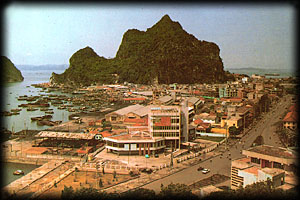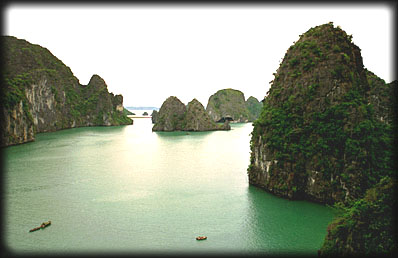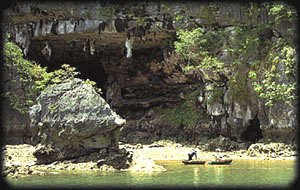The natural wonder of Halong Bay, renowned for its spectacular scenery and limestone grottos and caves, has been declared a UNESCO World Heritage Site. The bay is peppered with over 3,000 tiny islands emerging almost mystically out of the pea green waters of the Gulf of Tonkin, scoured by wind and wave erosion to form dramatic rock shapes, many of which contain caves filled with stalagmites and stalactites. Many of the islands have been named for their astonishing resemblance to their namesakes, such as Dragon, Incense Burner, Pair of Roosters and Man's Head Islands. The weird protuberances have been at the source of several local legends, particularly about the dragon whose thrashing tail created the bay and its islands. The name Ha Long means 'where the dragon descended into the sea'. The most impressive cave is the Hang Dau Go (Grotto of the Wooden Stakes), an extensive grotto with rock formations presenting various eerie images in the mysterious light. It was named from the Battle of 1288 when General Tran Hung Dao prepared hundreds of stakes to be planted in the riverbed of the largest chamber to counter a boat attack. Nearby the beautiful Hang Thien Cung cave is famous for its sparkling stalagmites and stalactites.
Nui Bai Tho, Poem Mountain, Halong
Poem Mountain stands over the city of Hon Gai. On his visit to Ha Long, King Le Thanh Tong (15th century) wrote a poem glorifying Ha Long's beauty. This poem is carved on a stele on Nui Truyen Dang which was later renamed Nui Bai Tho or Poem Mountain. The King was a poet and the person responsible for forming the group of intellectuals, Tao Dan Nhi Thap Bat Tu, or Tao Dan twenty-eight scholars.
Cua Ong Temple is located on a hill over looking Bai Tu Long Bay. The temple was built as a shrine to mandarin Tran Quoc Tang, the son of Vietnams most famous general Tran Hung Dao.
In 1283, during the height of the war against Mongolia, Tran Quoc Tang was sent here to build a fort to defend this frontier. This area was known for its rough and less than ideal conditions. Tran Quoc Tang created a government here and turned the area into a prosperous place. Tran Quoc Tang was made supreme commander and became one of Vietnams most successful general. During this period, there were many bands of outlaws and pirates harassing the people in this region. General Tang successfully wiped out many of these bandits and brought peace to this area. He was also successful in keeping the great Mongolian army at bay during their numerous attempt to invade Vietnam. The people revered him so much that he became a demigod to them. So much reverence was given to general Tang that he was dubbed King of the Sea while he was still alive!
Sung Sot Cave, Cave of Awe, Halong
Sung Sot Cave is on the same island with Trinh Nu cave. The path to Sung Sot is quite steep and is lined with shady trees. The cave has 2 chambers. The outer chamber is square and is often referred to as the waiting room. The cave's ceiling is approximately 30 m high. The walls are almost perfectly smooth as if it was built by man. The walls generate a variety of colors that blend with the setting of the area.
The path to the inner chamber is approximately 3m wide. The inner chamber is known as the serene castle. The formations in the chamber take the form of sentries conversing with one another, animals in varying poses etc. In the middle of the chamber stands a formation which resembles a general surveying his troops.
There is a side entrance which is approximately 6m in height. The light reflected from the moving water outside causes the formations inside the chamber to seemingly come alive. According to the locals, this was the reason the cave was named Sung Sot, from the awe-stricken reaction of the visitors to the cave.
Hang Dau Go, Flower On Stone, Halong
Hang Dau Go (Wooden Stakes Cave) is one of the most beautiful cave at Ha Long. The name, Dau Go or Giau Go, has direct ties to the history of Vietnam. According to the locals, while preparing for the Mongolian attacks in 1288, general Tran Hung Dao, sent a convoy to this area to cut wood from this region. Wooden stakes were then fashioned from the wood and hidden in Dau Go cave. The stakes were embedded in Bach Dang river to form a barrier against the attacking Mongols. According to legend, general Tran Hung Dao dealt a great blow to the Kublai Khan when he tricked the Mongolian army into chasing him deep up Bach Dang's channel. When the tide were down the enemies were stuck in these wooden stakes driven into the river bed. Dau Go was also the site where general Tran Khanh Du hid his force while waiting for the Mongols led by Truong Van Ho in 1287.
Dau Go is located on a limestone islet 8 km south of Bai Chay. The islet itself stands 187 m above sea level. Upon arriving visitors must hike the 90 rocky steps that lead to the cave's entrance. There are three chambers with the outer one having the most spectacular stalagmites and stalactites. Some are as tall as 20 m in height. The locals claim that these giant formations resemble human forms and are the keepers or guardians of Dau Go cave. The outer chamber is also the largest with capacity for three to four thousand people. The cave's floor is approximately 6 m lower than the entrance and the distance from floor to ceiling is approximately 25 m.
The middle chamber is accessible through a narrow passage approximately 1.4 m wide. There is a round crystal like structure on the path. When struck by light, this structure emits a kaleidoscope of light that is both breathtaking and unique. The inner chamber is famous for the colorful stalagmites and stalactites.
The inner chamber is much smaller by comparison. It is here that visitors will find stone wells filled with fresh water. According to the locals these wells are filled year round.
Dau Go is probably the most famous of all grottoes in Ha Long. Since its discovery, many Vietnamese dignitaries have visited Dau Go cave. In 1929, King Khai Dinh (Nguyen dynasty) visited Dau Go cave and was awed by its beauty. His praise in writing is carved on a stone stele at the entrance of the cave.
Hang Trinh Nu, Virgin Cave, Halong
Hang Trinh Nu (Virgin Cave) is also known as Mid Gate cave. According to local lore, an old couple lived here long ago. The husband made a living fishing around the bay. They were very poor. They had only one daughter. She grew up to be a beautiful young woman, so beautiful that people from all around knew of her. There were many suitors and her reputation reached the local mandarin. The mandarin immediately sent his soldier to her home to capture her. She was forced to marry the old mandarin.
After much cajoling and threats the fair maiden still steadfastly refused. One day, she escaped from the mandarins home, however she was afraid to return home for fear of retaliation. After much thought, the maiden decided to go to Mid Gate cave to commit suicide. Her body turned into the stone statue lying atop a flat surface. Since then, Mid Gate cave became known as Virgin cave.
Virgin cave tunnels through the middle of an island approximately 2 km long. Along the tunnel, there are many chambers. Each is famous for a different reason. All are unique in their beauty. Many visitors to the cave are awed by its beauty and so the name Hang Sung Sot was given to the outer chamber of the Virgin cave. Sung Sot literally means astonishment or awe.
|



